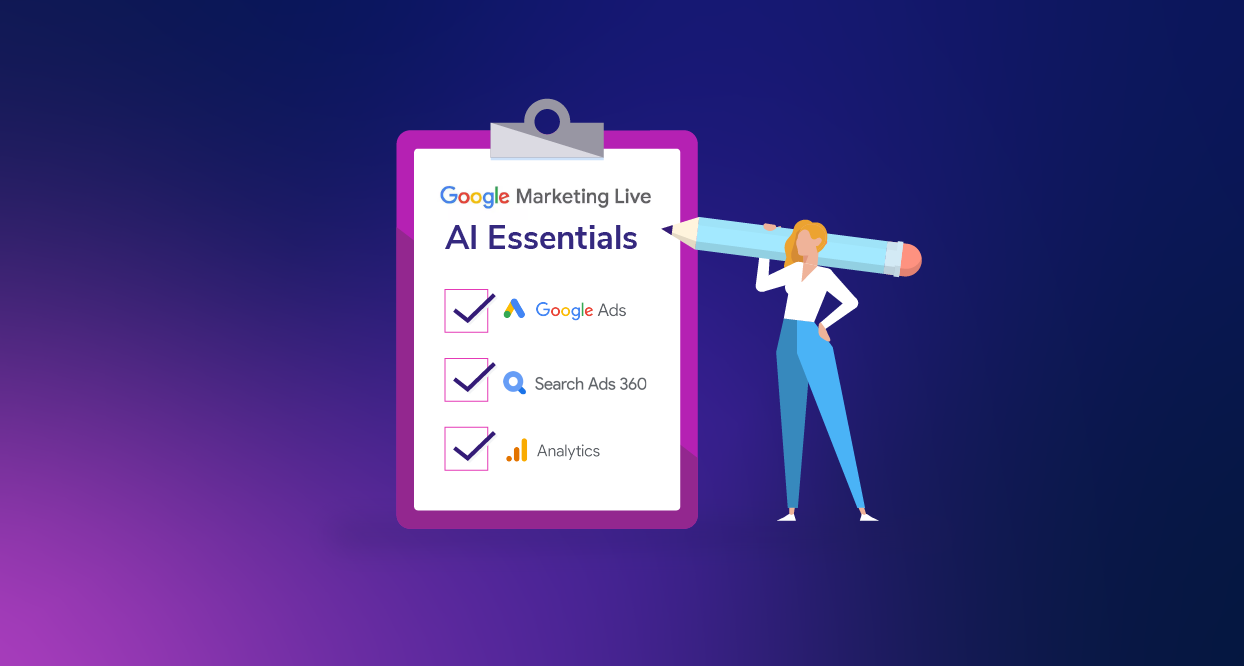The Bounteous Guide to Google’s AI Checklist for Marketing

It’s the year of AI, with mentions of AI peppering all the earnings reports from tech companies like Google, Facebook, Microsoft and more. To help businesses prepare for an AI-filled future, Google launched an AI Essentials checklist for its suite of marketing products. Google AI aims to enhance outcomes using advanced intelligence to help create better performing advertisements, build and edit quality creative, track and better predict user behavior through data models, and react more quickly to changing customer signals. Let’s dive in and understand what’s on the checklist, why it’s important, and how to take action.
First, let’s talk about what AI even means. Artificial intelligence is a branch of science where intelligence is demonstrated by machines instead of a living being (like a human or animal). There’s debate about the exact branches within AI, but some of the more common elements are Machine Learning, Language Processing, Speech Recognition, Vision, and Robotics.
AI has been a part of our lives for more than half a century, but in recent years has progressed into deeper models that help a machine to actually perceive, reason, problem solve, and more. Some examples of AI are speech-to-text, chatbots or phone prompts, and facial recognition. Now that we know what AI is, let’s review the checklist.
Lay the Foundation
Every project needs to have a solid foundation. With AI, you need to make sure that the inputs being fed to the artificial intelligence are correct and detailed. To put this in human terms, imagine that you were taking a class and the teacher provided the wrong information or not enough details. You wouldn’t have the knowledge needed to solve a problem or take a test.
Enhanced conversions help better track the accuracy of conversions in a post-cookie environment. It matches Google data with input data in a privacy safe manner and then can better attribute conversions. This is especially helpful on Safari and Firefox browsers where cookies are limited.
Our Recommendation: Try it out. It’s easy to enable and helps you from losing out on conversions your channel earned.
Not all conversions are equal; some customers are worth more than others. For better understanding of return on ad spend (ROAS) and improved bidding, assigning values provides additional clarity. It can be something simple such as the dollar total in a retail shopping cart, but can also include things like number of nights booked for a hotel, the value of a lead vs. a signup, or the amount in a funded financial account.
Our Recommendation: Understanding the quality of your leads or customers is incredibly valuable. If this task seems daunting, start by assigning at least one value and work up from there.
Some common silos are related to data, budget, and channel. It’s alright to specialize, but don’t sacrifice collaboration. Aligning incentives for the long term further drives this collaboration and allows channels to assist each other. Agile budgets can also help to drive business goals, with the theme of testing and learning consistently across teams.
Our Recommendation: Collaboration is always key to driving better business results. With agile budgets, just make sure that no changes are knee-jerk decisions—and don’t forget your testing framework.
If the checklist seems overwhelming, don’t worry—it will become more digestible with practice. Start at the top, build your foundation, and then take action. You also don’t have to do this on your own. Make sure your partners are aligned and embrace the potential of AI. The future of AI is here and as Google stated: “You’re not competing against AI. You’re competing against marketers who are already using AI.”


